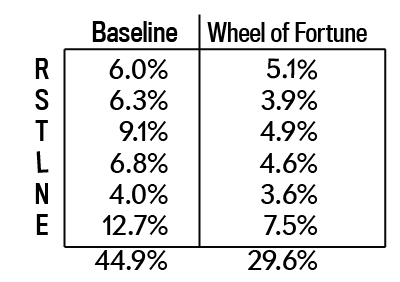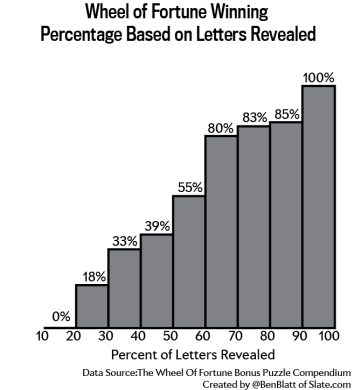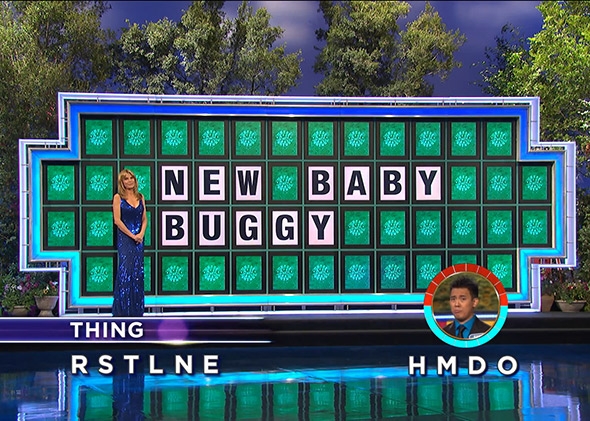The Hardest Puzzles in Wheel of Fortune History
Where does NEW BABY BUGGY rank? Plus: Try your hand at the toughest solves ever.
In a recent episode of Wheel of Fortune, contestant Emil de Leon accomplished what host Pat Sajak would later describe on Twitter as the “most amazing solve in my 30+ years on the show.” De Leon was able to complete the game’s final puzzle—the category was “Thing”—with only two letters to go on: “NE_ _ _ _ _ _ _ _ _ _.” With his first guess, he blurted out “New Baby Buggy”—which turned out to be the improbable answer.
It's become a Slate tradition to overanalyze game shows, and de Leon’s triumph inspired me to turn my attention to Wheel of Fortune. I wondered: Is this truly the greatest solve in the game show’s long history?
Try your hand at our Wheel of Fortune interactive:
Guessed Letters:
Incorrect Guesses: 0
Press Enter to Begin
A word about my process: My analysis is limited in its scope by the solutions recorded on the Wheel of Fortune Bonus Puzzle Compendium and this puzzle archive, neither of which is complete. But, combined, the two sites have recorded almost 13,000 puzzles from the game show’s opening rounds and over 2,000 bonus-round puzzles going back (intermittently) to 1988. Both of these sites are maintained by viewers, and there is no official record keeping for the show. So my analysis is dependent on the accuracy of these committed Wheel of Fortune superfans. That said—they seem very committed.
As regular Wheel watchers know, the bonus round, in which Emil’s triumph occurred, operates somewhat differently than the regular rounds of play. Since a rule change in 1988, contestants have been given the letters RSTLNE automatically. They are then allowed to guess three additional consonants and one additional vowel. This should be great news for contestants, as RSTLNE represent approximately 45 percent of all letters in a standard English text. However, of the more than 22,000 letters in the Wheel of Fortune bonus puzzles in my sample, RSTLNE only account for 29.6 percent of all letters—a statistically significant discrepancy.

For obvious reasons, the show’s producers seem to be choosing words and phrases that are light on RSTLNE, at least in the bonus round. During the regular rounds, RSTLNE show up about as often as you’d expect them to: In my sample, the total frequency of RSTLNE was 44.7 percent, very close to the 44.9 percent you’d expect from the English language writ large.
After RSTLNE are revealed in the bonus round, a player gets to request his four additional letters. The N and the E that showed up in Emil’s puzzle obviously came from the free letters every contestant is given. For his additional letters, he chose H, M, D, and O, netting him no additional letters in the puzzle. Was Emil unwise to pick H, M, D, and O?
If Emil were to pick letters purely by their frequency in the English language, he should have guessed H, D, C, and A instead of H, D, M, and O. But the difference in frequency between M and C or A and O is not huge—at least in real life. Recall, however, that bonus round answers do not have the same letter frequency you find in the English language. The three consonants and one vowel that show up most frequently in the bonus round are H, G, B, and O.
Picking H, G, B, and O in all past rounds would have netted contestants 3 percent more letters revealed than picking H, D, C, and A. This is useful information for contestants. O is usually the fourth most popular letter in the language, with a frequency of 7.5 percent, but it has a frequency of over 9.6 percent in the universe of Wheel of Fortune bonus rounds. Even if you split the bonus round sample chronologically into five equal samples of 400 puzzles, in order to test for random blips over time, O is the most popular letter in every sample. The fact that O appears more frequently than letters that usually best it—like E, T, or A—suggests its high frequency is likely not random.
Historically, if all bonus-round contestants had guessed the combination of HGBO at every opportunity, the four letters would have revealed 22.5 percent of all bonus round letters. In reality, however, contestants rarely guess HGBO—and sometimes they guess strange combinations of unlikely letters, like PKWI or ZJWI. Based on each letter’s frequency in the bonus round, statistics would suggest that their guesses should have revealed only 18.5 percent of all letters. However, contestants’ guesses have actually revealed 21.9 percent of all letters, not far off from the 22.5 percent my HGBO advice would yield. It appears contestants are making educated guesses based on what RSTLNE has already indicated about a given puzzle.
That said, every letter counts. De Leon came up empty with his guess of HDMO. If he had guessed my grouping of HGBO, he’d have been looking at this: NE_ B_B_ B_GG_. Ultimately, he didn’t need the help. But for most contestants, those letters might have been the difference between winning $45,000 or going home empty-handed.
Maximizing the number of letters revealed greatly increases your chances of winning. The chart below plots the percentage of total letters revealed (either by player guess or by RSTLNE) along the X-axis, against the win percentage of players on the Y-axis. For example, contestants who have revealed 75 percent of a puzzle’s letters when the final countdown starts (players have 10 seconds to solve the bonus round puzzle, with unlimited guesses) go on to guess the correct answer 83 percent of the time. Even a mediocre Wheel player can likely solve something like B U S R _ U T E.

When Emil was presented with “NE_ _ _ _ _ _ _ _ _ _” roughly 17 percent of all the letters in the phrase were visible. Only about 30 people had been in a similar position to Emil’s—that is, with less than 20 percent of all letters revealed—and none of them had ever managed to win.
Again, my analysis is based on the available data, which has some holes in it, and doesn’t date all the way back to the show’s debut in 1975. But based on my sample, it’s safe to say that de Leon’s probably is the most amazing solve ever, from a statistical perspective. When you consider that “New Baby Buggy” is a phrase few people have ever heard, let alone would offer up as a guess were they in Emil’s shoes, the guess is even more remarkable.
Curious to see if you have the solving skills to crack a puzzle like Emil’s? The quiz above includes puzzles from the 15 bonus rounds, out of over 2,000 in my sample, in which the fewest number of letters were revealed but the contestant still managed to guess the correct answer. Armed with the same letters, see if you can solve these puzzles in that short, 10-second window. G_O_ L_C_!
Correction, March 27, 2014: Several puzzles in this article's interactive feature did not include some given letters, such as R or T, or offered an incorrect letter, such as C instead of G. This has been fixed.
